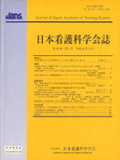Japanese
English
- 販売していません
- Abstract 文献概要
- 参考文献 Reference
- サイト内被引用 Cited by
要旨
目的:救急・集中治療を要する重症意識障害患者に対する家族成員の認識を明らかにし,看護支援を探求すること.
方法:本研究は,グラウンデッド・セオリー・アプローチを用いた質的帰納的研究である.急性期治療終了後の状態がGCS10前後の意識障害患者の家族成員を参加者とし,理論的サンプリングによって8名得た.参加観察法,半構成的面接法により得られたデータを継続的比較分析した.
結果:〈嘘と本当の交叉〉を基点とし,〈生きていてくれればいい〉〈もとに戻って欲しい〉〈もとには戻らないかもしれない〉〈変化の受け入れ〉の順に変化する4つの位相カテゴリーで構成された認識プロセスを見いだした.このプロセスの中心的現象は,《意識障害患者とのつながりに対する希望と落胆の共存状態》とカテゴリー化され,本研究のコアカテゴリーに位置づけられた.さらに家族成員は,[ゆらぎ][ささえ手][後押し]との相互作用を通して希望を持ちながら意識障害患者を引き受けていることが明らかとなった.
結論:各位相における家族成員の認識を適切にとらえたうえで支持的に関わる重要性が示唆された.
Abstract
Objective:To clarify the awareness of family members of patients with severe consciousness disorder within about 1 month of sudden onset who require nursing support.
Methods:The present qualitative inductive research employed a grounded theory approach. Participants were family members of patients with consciousness disorders with a GCS of approximately 10 at the end of acute care. Eight family members were chosen by theoretical sampling. Data obtained by the participant-observer and semistructured interview methods were subjected to constant comparison analysis.
Results:From the base point of “the intersection between truth and lie,” an awareness process consisting of the following four phase categories was identified:“I just want the patient to live”;“I want the patient to get back to normal”;“The patient may not return to normal”;and “acceptance of change,” in that order. The central phenomenon of the process was categorized as “coexistence of disappointment and hope for the patient with consciousness disorder” and was positioned as the core category of the present research. Furthermore, family members accepted patients with consciousness disorder with hope based on interactions among “wobbling,”“supporting them” and “furthering of acceptance.”
Conclusion:These results suggest the importance of supporting family members by understanding their awareness in each phase.
Copyright © 2011, Japan Academy of Nursing Science. All rights reserved.


